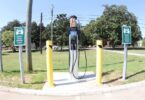Provided by the Pennsylvania Department of Insurance:

Marines with Camp Lejeune in North Carolina help push a car out of a flooded area during Hurricane Florence on September 15.
Credit: Lance Cpl. Isaiah Gomez/U.S. Marine Corps
With automotive officials estimating as many as 40,000 vehicles were damaged by flooding from Hurricane Florence, the Pennsylvania Insurance Department and PennDOT warn consumers to be on the lookout for flood-damaged cars being sold as undamaged new or used vehicles.
“Though not all states were directly affected by Hurricane Florence, flood-damaged cars could potentially end up in the market across the country,” said PennDOT Secretary Leslie S. Richards. “It’s important that consumers are aware of how to spot a vehicle that may be flood-damaged.”
Things to check for that may indicate a vehicle has flood damage:
- Water stains, mold, mud or sand under the carpets, seats, floor mats, inside roof cloth and under the dashboard.
- Rusty metal inside the car. The inside of a car does not usually rust.
- Musty odors in the trunk and in the passenger compartment (especially when running the A/C or heat)
- Fog or moisture inside interior and exterior lights and excessive fogging of windows and condensation on windows.
- Mud or grit in the spare tire compartment and under the hood. When checking under the hood, be sure to look under wires, boxes and in hidden areas.
- Oxidation under the hood. Oxidation on metal can look like white powder or it could even be small holes called pitting.
- Brittle wires under the dashboard, speakers and hood.
A checklist of items that may indicate a vehicle is flood-damaged is available at www.insurance.pa.gov, by clicking on “Auto” under “Insurance Coverage Resources.”
Flood-impacted vehicles that have been issued a certificate of salvage are required to undergo an enhanced vehicle safety inspection prior to being issued a title in Pennsylvania. Upon successful completion of the enhanced inspection, a Pennsylvania title will be issued with a Flood or Reconstructed Flood brand.
“Consumers buying a vehicle with a salvage certificate or flood title should be aware of possible implications if they file an insurance claim on the vehicle. Even if the vehicle is new if a claim is later filed, the insurance company will research the vehicle history and see the prior claim for flood damage,” said Insurance Commissioner Jessica Altman. “If the vehicle is deemed to be a total loss, the insurer will likely pay out significantly less than would be paid for a vehicle that did not have flood damage.”
Insurers also may not be willing to provide comprehensive and collision coverage on flood-damaged vehicles because the insurer can’t be sure of the vehicle’s value or how complete any repairs are. Getting a loan for a vehicle without full comprehensive and collision coverage is nearly impossible, so consumers would likely have to pay cash for the vehicle.
Consumers can also use the National Insurance Crime Bureau’s VINCheck database, to see if the vehicle had a claim for flood or other damage filed,” Altman said. VINCheck is a free public service available at www.nicb.org/vincheck.
Consumers can also check reference services, such as the National Motor Vehicle Titling Information System (NMVTIS). NMVTIS is overseen by the U.S. Department of Justice and is designed to protect customers from fraud and unsafe vehicles, and to help keep stolen vehicles from being resold. NMVTIS is the only publicly available system in the country that requires all insurance carriers, auto recyclers, junk and salvage yards, and states to report vehicle history information.
Consumers can visit http://www.vehiclehistory.gov to view the title history for any vehicle: all that’s needed is the VIN number of the vehicle and for a nominal fee – between three and five dollars – you can obtain vehicle history information from one of NMVTIS’ approved data providers. Additional information on NMVTIS is also available on PennDOT’s Driver and Vehicle Services website, www.dmv.pa.gov, by clicking on the Vehicle Services menu, then the “NMVTIS” button.








